|
SpaceTides e-zine
#46 – 1 August 2006
Internet
Newsletter of ASSA Bloemfontein Centre, South
Africa, to the public
www.assabfn.co.za/spacetides

|
Subscribe to the free SpaceTides e-zine by
sending an e-mail to spacetides@assabfn.co.za
with the word "Subscribe" in the subject line if you are not
already subscribed. |
In this issue of SpaceTides |
INDEX
WARNING!! Beware the MARS HOAX! -
see heading in red below.
1. Spaceflight news from
around the world
2. Astronomy news from around the world
3. Interesting space facts
4. The Solar System: Our Sun (first of 12
part series)
5. Sky Observation log
6. Astronomy & Science in
Southern Africa
7. Observatories of the World
8. Photo Sense
9. Web links
Hello
SpaceTides Subscribers
First of all, it seems that the Mars Hoax email is doing the rounds
again. I couldn't believe what I saw! And people actually tend to believe it.
If you get one of these emails claiming "Mars will come very close to
the Earth" (and become as big as the full moon), simply ignore it. More
info below.
You can now also subscribe to the free ASSA
web update service. A short and to-the-point monthly update with internet
links to news and events about SA astronomy. All subscribers are invited to
make use of this opportunity (click link above or reply to this email with
the word "ASSA" in the subject line and I will put you on the
list).
I'm sending a separate email with more information about the national ASSA
Symposium to be held at Boyden Observatory in Bloemfontein. You are
welcome to attend, hope to see some you of you there! It promises to be a
full and exciting event.
All the best,
Gerrit Penning
Editor
Total subscribers as at 1 August: 633 (+78 from previous issue
#45)
|
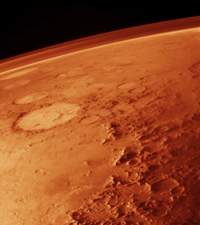
|
Debunking
some really inaccurate data
Many of you
might have received it already. The malicious e-mail hoax claiming that, on
27 August, Mars will come extremely close to the Earth. So close in fact,
that it will be as large as the "full moon"! It also claims that
Mars will easily be visible and only within
56 million km from the Earth. Some of this was true for August 2003.
It's totally false now.
Let's quickly set the record straight:
1. For the month of August 2006, Mars will not be easily visible!! It
is so close to the western horizon in the glare of the sun as to make it very
difficult to discern properly.
2. On 27 August 2006, Mars will not be 56 million km away, it will
be 386 million km away. That's pretty much on the other side of the
Sun...
3. If Mars is 56 million km from the Earth, it will NOT appear as large as
the full moon. In August 2003 Mars came within 56 million km, the closest
in 60,000 years, and it was nothing more than a bright speck of light in the
sky - the layman wouldn't even have noticed at all. Just think
of what will happen to the tides if Mars came so close to the Earth as to be
as large as the "full moon". Total mayhem... So please ignore
that hoax!!
Go to this Snopes.com article to read the hoax (green box). |
___________________________________________________________________________________________
1. Spaceflight news from around the world |

Radar images of Titan's
surface. Credit: NASA/JPL
|
Cassini
Finds Lakes on Titan's Arctic Region
From a JPL news
release dated 27 July 2006. Read full article.
NASA's Cassini spacecraft has found lakes on Saturn's largest moon Titan. The
lakes are most likely the source of hydrocarbon smog in the frigid moon's
atmosphere. Finding the source of these hydrocarbons
("koolwaterstof" in Afrikaans) in Titan's atmosphere has been a
major goal for the Cassini mission and is a significant accomplishment.
Scientists have now seen a place other than Earth where lakes are present.
Cassini took radar images of dark patches resembling lakes. At Titan's very
cold temperatures, about minus 180 degrees Celsius, the liquids in the
lakes are most likely methane or a combination of methane and ethane. Scientists had predicted, but had no confirmation until
now, that pools of liquid were contributing to the high concentration of
methane and other hydrocarbons in Titan's atmosphere.
Cassini's next flyby of Titan is on 7 September 2006. In October, Cassini's
radar will look even closer to the north pole, searching for more lakes and
mapping more of the polar region covered by these features. |
________________________________________________________________________________________
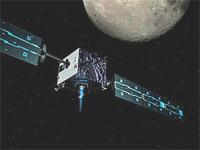
Artist impression of SMART-1 near the Moon. ESA.
|
Lunar
Probe to crash into the Moon
From ESA's
SMART-1 website, "Approaching the mission end". Link.
After almost 16 months of studying the Moon, the SMART-1 lunar probe is about
to end its mission and it is going to make a big impact (literally!)
It reached the Moon in November 2004 after a long spiraling around
Earth. In this initial phase, the spacecraft tested a series of advanced
technologies (including an ion engine and gravity assist manoeuvres). After
extensively studying the Moon, operators are going to crash the probe into
the lunar surface on 3 September. This date allows for further capturing of
high resolution data and the opportunity for ground-based telescopes to see
the impact from Earth.
The telescopes will try to observe the dust ejected by
the impact, hoping to obtain physical and mineralogical data on the surface
excavated by the spacecraft. |
2. Astronomy news from around the world |
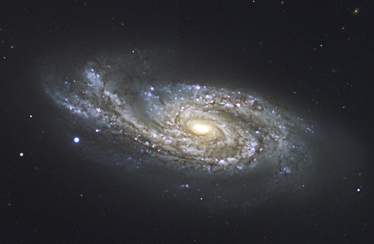
Starburst galaxy NGC 908 Credit: ESO
|
Galaxies
with a Twist
Extracted and edited
from an ESO press release dated 27 July 2006. Read full
article.
ESO's Very Large Telescope has photographed various 'Island Universes', which
all have some peculiar characteristics. The galaxy pictured here is NGC 908,
located 65 million light-years towards the constellation of Cetus (the
Whale).
It is a so-called "starburst galaxy" - a galaxy undergoing a phase
where it spawns stars at a frantic rate. The galaxy also displays uneven and
thick spiral arms. This indicates that it may have undergone a close
encounter with another galaxy in the past. Clusters of young and
massive stars can be seen in the spiral arms. |
________________________________________________________________________________________
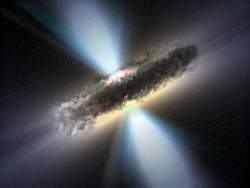
Computer rendering of rays emitted by a supermassive black hole. ESA /
V. Beckmann (NASA-GSFC)
|
Those
elusive Supermassive Black Holes
Extracted and
edited from an ESA news release dated 26 July 2006. Read full article.
Scientists trying to find supermassive black holes hiding in nearby galaxies
have found surprisingly few. Either the black holes are better hidden than
scientists realised or they are lurking only in the more distant universe.
They might be hiding behind thick clouds of dust. These dusty shrouds allow
only the highest energy X-rays to shine through. The X-rays combine into a
cosmic background of X-rays that permeates the whole of space. Observations
show that there are clearly too few hidden black holes in the nearby Universe
to create the observed X-ray background radiation.
The X-ray sky is thousands to millions of times more energetic than the
visible sky familiar to our eyes. Much of the X-ray activity is thought to
come from black holes violently sucking in gas from their surroundings. The
challenge now is to see them... |
3. Interesting Space Facts |
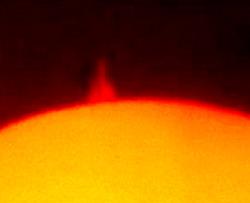
An H-Alpha view of the Sun with a solar prominence clearly visible.
Taken by Jacques van Delft (ASSA Bloemfontein). More info.
|
Facts
about our Sun
-The diameter of the
Sun is about 1.4 million kilometers. This is 110 times more the Earth's. The
Sun's volume is big enough to hold more than 1.3 million Earths.
-The Sun is about 4.6 billion years old. It has already used up almost half
of its hydrogen supply in its core and will "run out of gas" in
about 5 billion years. It will then expand and engulf all of the inner
planets. After its destruction, a planetary nebula will most probably be left
over, with the Sun as a white dwarf in the centre.
-The Sun contains more than 99.8% of the total mass of the whole solar system
(with Jupiter taking up most of the rest).
-If you travel to the Sun at 120 km/h (as with a car), it will take you 142
years to reach the Sun! |
4. The Solar System: Our Sun |
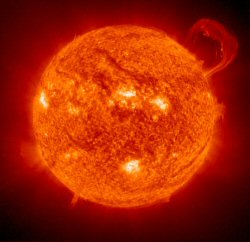
The Sun - courtesy SOHO Consortium
(ESA / NASA). More SOHO images.
|
Our
nearest star, the Sun
The Sun is on
average 150 million km from the Earth. This is actually very close in cosmic
terms. We thus have a star close to us which we can study directly. Much
research is performed on the Sun, but equally many questions still remain.
Scientists are only now beginning to understand the impact that the Sun have
on the environmental and climatical systems here on Earth. We are very
fortunate to have such a stable and ordinary Sun - without such
characteristics, intelligent life on Earth would have been in grave danger,
or might never have existed at all.
The Sun’s energy is created deep down in its core. The temperature here
is estimated to be 15 million° C! (surface temperature approaches 6 000°
C). These reactions are so intense that nuclear fusion takes place.
When hydrogen particles fuse together to form helium, energy is emitted.
Every second, 700 million tons of hydrogen are converted into helium.
The Sun makes one rotation around its own axis in just over 25 days. It
is being studied by orbital satellites as well as Earth-based observatories.
More about amateur solar observations on ASSA Bloemfontein's solar page. |
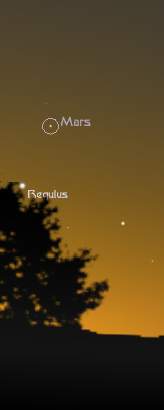 Credit: Stellarium Credit: Stellarium
|
Planets - August 2006
Mercury is in the morning sky for the first 3 weeks of the month.
Venus is also in the morning sky, visible for the entire month.
Earth is probably the best place for intelligent life in the solar
system. It's not too hot, not too cold, geologically pretty stable and if you
don't live in the largest its cities, the atmosphere is also quite
breathable.
Mars is visible just after the Sun sets, but is very close to the
western horizon in the Sun's glare.
Jupiter shines bright overhead in the evening sky, setting shortly
after midnight.
Saturn only reappears in the morning sky at the end of August.
Constellations
and stars - evenings of August 2006
To the North: Hercules (the Hero) are fully visible in all its
mythological splendour. To its "right" is Lyra (the Lyre), with the
star Vega monopolising the northern sky with its brightness.
Mid-sky: Sagittarius (the Archer) is now well-situated for observation
and Aquila is rising in the east.
To the South: Ara (the Altar) is still the perfect hunting-ground for
deep sky objects while Triangulum Australis, Apus (the bird of Paradise) and
Pavo (the Peacock) dominates the southern-most skies.
Have you tried to find Sigma Octantis yet? It is the star closest to
the south celestial pole. You can attempt to locate it with a binocular.
Deep sky Objects
- August 2006
Sagittarius deep
sky objects: Use a telescope to find the numerous Messier objects in this
superb constellation. Look at M25 (Open Cluster), M8 (bright
"Lagoon" nebula), M22 (large Globular Cluster), M17 (Swan
nebula!!), M20 (Triffid Nebula). Recommended: a telescope with 6 to 8 inch
aperture and up.
Other night sky
events
- Full Moon on 9 August 2006. New Moon on 23 August 2006.
- The moon occults Antares as seen from Cape Town on 4 August 2006. Observers
more north should still watch - they will be very close to each other.
Actually something not to miss! |
6. Astronomy & Science in Southern Africa |

|
SKA
South Africa and KAT news updates
Visit the newsletter
site of the Square Kilometer Array / Karoo Array Telescope for up to date
information pertaining to these exciting projects.
Website: http://www.ska.ac.za/newsletter/
You can also join the mailing list free of charge. The competition runs high
between the countries hoping to host the mega SKA project. South Africa -
let's wish the representatives good luck. If SA wins the bid, we can say that
we have the world's most powerful, largest radio telescope! |
__________________________________________________________________________________________
ASSA national web update
Subscribe
to the free ASSA web
update service. You receive a monthly email
with links to news happenings and events in Southern African astronomy. It
comes highly recommended.
__________________________________________________________________________________________
Southern Sky Talk Podcast
We
are constantly bombarded with reading material from all directions. Now you can listen to what's up in the
Southern African sky by simply clicking on the Southern Sky Talk podcast
link: brought to you by psychohistorian.org.
__________________________________________________________________________________________
Astronomy links for Southern
Africa
For more SA Astronomy
websites, go to the SpaceTides SA Astronomy Portal at:
www.assabfn.co.za/spacetides/sa_astronomy.htm
7. Observatories of the World |
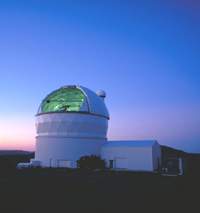
|
McDonald
Observatory and the Hobby-Eberly Telescope
The McDonald
Observatory is located in the Davis Mountains, some 720 km west of Austin,
Texas in the United States. The Observatory is equipped with various
state-of-the-art instrumentation for imaging and spectroscopy in the optical
and infrared, and operates one of the first and most productive lunar ranging
stations. Currently, the Observatory operates four research telescopes:
9.2m Hobby-Eberly Telescope
2.7m Harlan J. Smith Telescope
2.1m Otto Struve Telescope
0.8m Telescope
The South African Large Telescope (SALT) is based on the design of the
Hobby-Eberly Telescope.
Left: Dome of the Hobby-Eberly 9.2 m telescope (souce).
Website: http://www.as.utexas.edu/mcdonald/ |
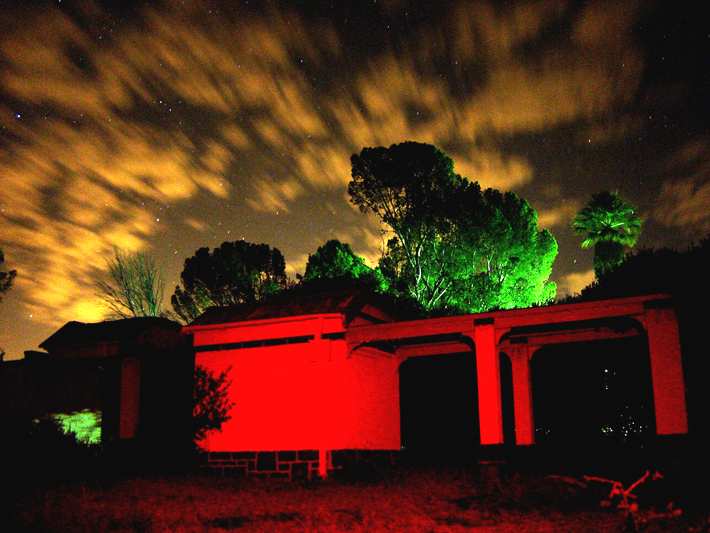
A night photo taken at Boyden Observatory on 17 June 2006 by Gerrit
Penning. The image shows one of the numerous telescope buildings on the
Boyden hill, "painted" red by a flashlight while the photo was
exposed for 30 seconds. The fast-moving clouds are evident and the trees
display a vivid green colour.
|
_____________________________________________________________________________________________________________________
SpaceTides is a free internet e-zine for persons interested in expanding
their general knowledge of astronomy and spaceflight.
The e-zine originates from the City of Bloemfontein in South Africa and is
compiled us a service to the public by ASSA Bloemfontein Centre
as part of their educational outreach activities. Website: www.assabfn.co.za.
SpaceTides contains links to various other third party sites on the
internet, not always connected to SpaceTides. The persons and entities
responsible
for compiling SpaceTides will not be held responsible for the content or
information on these third party sites or any damage of any kind incurred
from
downloading, opening, or viewing anything from/through these sites.
If you would like to unsubscribe from SpaceTides, send an e-mail to spacetides@assabfn.co.za with the word
"Unsubscribe" in the subject line.
_____________________________________________________________________________________________________________________________
|



